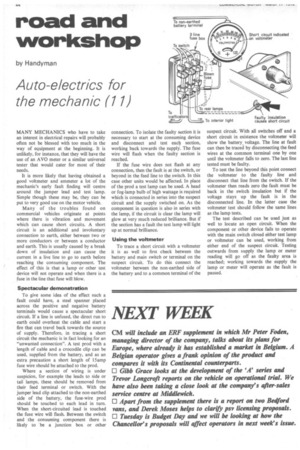road and workshop
Page 46

If you've noticed an error in this article please click here to report it so we can fix it.
by Handyman
Auto-electrics for the mechanic (17)
MANY MECHANICS who have to take an interest in electrical repairs will probably often not be blessed with too much in the way of equipment at the beginning. It is unlikely, for instance, that they will have the use of an AVO meter or a similar universal tester that would cater for most of their needs.
It is more likely that having obtained a good voltmeter and ammeter a lot of the mechanic's early fault finding will centre around the jumper lead and test lamp. Simple though these may be, they can be put to very good use on the motor vehicle.
Many of the troubles found on commercial vehicles originate at points where there is vibration and movement which can cause short circuits. A short circuit is an additional and involuntary connection to earth, either between two or more conductors or between a conductor and earth. This is usually caused by a break down of insulation and can cause the current in a live line to go to earth before reaching the consuming component. The effect of this is that a lamp or other test device will not. operate and when there is a fuse in the line that fuse will blow.
Spectacular demonstration To give some idea of the effect such a fault could have, a steel spanner placed across the positive and negative battery terminals would cause a spectacular short circuit. If a line is unfused, the direct run to earth could overheat the cable and start a fire that can travel back towards the source of supply. Therefore, in tracing a short circuit the mechanic is in fact looking for an "unwanted connection". A test prod with a length of cable and a crocodile clip can be used, supplied from the battery, and as an extra precaution a short length of 15amp fuse wire should be attached to the prod.
Where a section of wiring is under suspicion, for example the leads to side or tail lamps, these should be removed from their feed terminal or switch. With the jumper lead clip attached to the non-earthed side of the battery, the fuse-wire prod should be touched to each lead in turn. When the short-circuited lead is touched the fuse wire will flash. Between the switch and the consuming component there is likely to 'be a junction box or other connection. To isolate the faulty section it is necessary to start at the consuming device and disconnect and test each section, working back towards the supply. The fuse wire will flash when the faulty section is reached.
If the fuse wire does not flash at any connection, then the fault is at the switch, or beyond in the feed line to the switch. In this case other units would be affected. In place of the prod a test lamp can be used. A head or fog-lamp bulb of high wattage is required which is connected in series into the suspect circuit and the supply switched on. As the component in question is also in series with the lamp, if the circuit is clear the lamp will glow at very much reduced brilliance. But if the section has a fault the test lamp will light up at normal brilliance.
Using the voltmeter To trace a short circuit with a voltmeter it is as well to first check between the battery and main switch or terminal on the suspect circuit. To do this connect the voltmeter between the non-earthed side of the battery and to a common terminal of the suspect circuit. With all switches off and a short circuit in existence the voltmeter will show the battery, voltage. The line at fault can then be traced by disconnecting the feed wires at the common terminal one by one until the voltmeter falls to zero. The last tine tested must be faulty.
To test the line beyond this point connect the voltmeter to the faulty line and disconnect that line from the switch. If the voltmeter then reads zero the fault must be back in the switch insulation but if the voltage stays up the fault is in the disconnected line. In the latter case the voltmeter test should follow the same lines as the lamp tests.
The test described can be used just as well to locate an open circuit. When the component or other device fails to operate with the main switch closed either test lamp or voltmeter can be used, working from either end of the suspect circuit. Testing outwards from supply the lamp or meter reading will go off as the faulty area is reached; working towards the supply the lamp or meter will operate as the fault is passed.










































































































